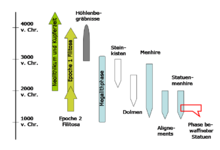Alignment by Stantari
The megalithic Alignement de Stantari is located on the French Mediterranean island of Corsica near the dolmen of Fontanaccia and the Alignement of Renaggiu in the southwest of the Sartènais .
nature
Those in the Bronze Age between 1500 and 1000 BC Both rows of stones , dated BC , consist of more than 20 erect menhirs or statue menhirs .
Your front is directed to the east. The stones, long hidden under an old wall, were uncovered by Roger Grosjean's excavations in 1964. The two statues in the northern area of the stone row, named "Cauria II" (2.78 m high) and "Cauria IV" (2.91 m high) after the nearby town of Cauria, are among the largest in Corsica. They are the only statue menhirs with indicated arms and hands. A “dagger sword” can be recognized as an attribute, which is carried in a hanger on the chest with a shoulder strap. A kind of loincloth is attached to the sword, which forms a crooked line motif on the back of the menhir.
- Alignment by Stantari
The vertical engravings on the back are interpreted as the spine or straps of the sword hanger . The two indentations (with a diameter of 7 cm and a depth of 3 cm) on the sides of the head above the forehead are interesting. According to Grosjean, they were used to attach horns , so that it is a Bukranion . Traces of red paint on Cauria II and IV indicate, among other indications, that these and other menhir statues were painted with red ocher . In terms of clothing and armament, the two statues were compared with sea peoples representations in Egypt and regarded as an indication that the Shardana came from Sardinia, since the culture of the “Torre people” depicted on Cauria II and IV shows parallels with the contemporary Sardinia.
See also
literature
- Eugène Bonifay (ed.): Préhistoire de la Corse. Center Regional de la Documentation Pédagogique, Ajaccio 1990, ISBN 2-86620-50-3
- Andre d'Anna: Les statues-menhirs de Corse: chronologie et contextes, l'exemple de Cauria
- Florian Soula: Le phénomène des pierres dressées en Corse: chronology, rôles, significations et perspectives
Individual evidence
- ↑ Baedeker Corsica in the Google book search
- ↑ La Corse avant Prehistoire , p. 69
- ↑ August Strobel : The Late Bronze Age Sea Peoples Storm. A research overview with conclusions on the biblical Exodus topic (= magazine for Old Testament science . Supplements. 145). Walter de Gruyter, Berlin et al. 1976, ISBN 3-11-006761-7 , p. 198 f.
Web link
- official brochure ( Memento of November 8, 2007 in the Internet Archive ) (PDF file; 1.40 MB)
Coordinates: 41 ° 31 ′ 49 ″ N , 8 ° 55 ′ 17 ″ E


